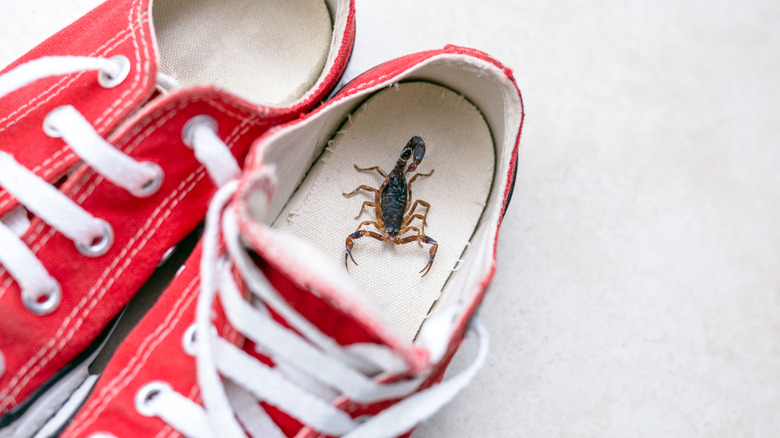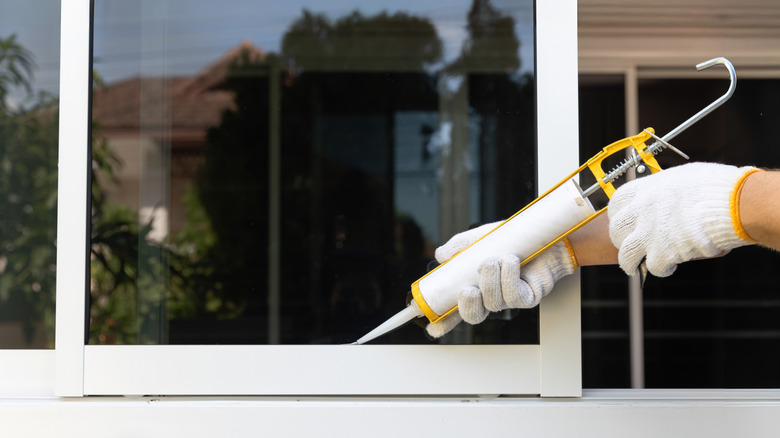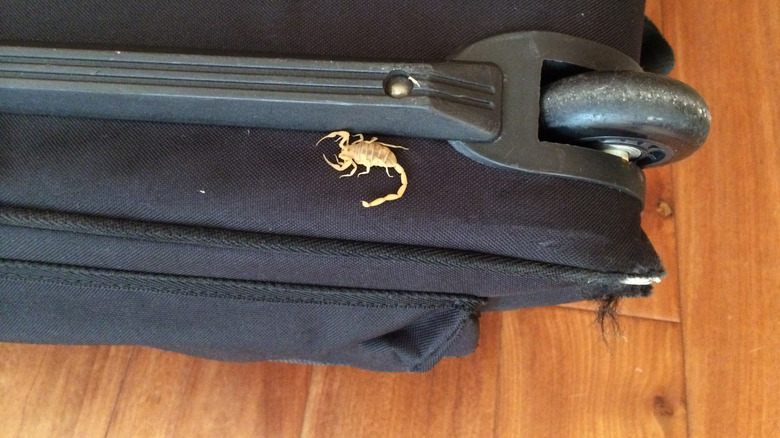Scorpion Infestations In Arizona Are Out Of Control. Here's What Locals Can Do About It
We may receive a commission on purchases made from links.
Thanks to an extremely mild winter and unusually warmer temperatures this year, scorpions are taking over Arizona. With their usual seasonal patterns disrupted, scorpion populations are exploding. Not only did scorpions start mating earlier, but overall weather conditions have also increased the populations of all insects. That's provided the Arizona arachnids with plenty of prey, keeping them more active than usual. With close to 60 native species, Arizona is always a state where you're likely to spot the fascinating ancient creatures. Armed with a UV flashlight like the ESCO LITE from Amazon, their glow-in-the-dark exoskeletons make for a magical moonlit hike in the desert. But when you find a scorpion inside your shoe or waiting to pinch you from a pantry shelf, the experience can quickly turn unpleasant. Fortunately, from sealing entry points to setting out glue traps, there are several steps you can take to prevent or address a scorpion infestation in your home.
The first thing you need to do if you find a scorpion crawling around your house is correctly identify it. Although there are several species that might sneak inside, the Arizona bark scorpion is the most common culprit. The most venomous scorpion in all of North America, you'll recognize it by the light tan color, elongated pincers, and curved tail that looks like a tiny string of sausages. Like the scorpion itself, its stinger is tiny. Thousands of people in Arizona are stung each year, a painful experience that can cause numbness, tingling, vomiting, and even more serious issues like temporary limb paralysis, convulsions, or shortness of breath. Although these symptoms typically subside in a day or two, prevention is the best cure.
How to prevent scorpion infestations
Most of Arizona's scorpions are extremely small, and all of them are nocturnal – traits that can help them creep into your home unnoticed until it's too late. Keeping them out is the best way to protect your family. Caulking exterior doors and windows is a great place to start. Use a weather stripping product or expanding foam like Loctite Gaps & Cracks Spray Foam Sealant. You can also add door sweeps like the bestselling GroTheory Weather Stripping Door Seal on your screen or sliding doors. Sealing your attic and making sure your vents are secure is another way to prevent your home from becoming a haven for scorpions. As summer temperatures start to skyrocket in Arizona, they will quickly make themselves at home in the dark, sheltered, undisturbed space if you don't.
There are additional steps you can take outside your home to discourage scorpions from becoming the worst neighbors you've ever had. Cut back any bushes or other vegetation that touches the exterior walls so scorpions won't have anywhere to hide. And get rid of any piles of wood, compost, or even wet leaves that will provide the moist, dark conditions scorpions love. You could also try sprinkling diatomaceous earth around the perimeter of your home. The all-natural dust kills a variety of bugs by drying out their exoskeletons, essentially dehydrating them until they die. It's a rough way to go out, but if you want to keep scorpions from infesting your home and harming your family, products like Harris Diatomaceous Earth Crawling Insect Killer with Powder Duster can make a big difference.
What to do if you find scorpions in your home
According to exterminators and health officials across Arizona, scorpion sightings are on the rise. If you spot one hanging out on a sun chaise in the backyard, to avoid getting stung, it's a good idea to grab it with a pair of kitchen tongs instead of dispatching it with your bare hands. But what if you find one in your laundry basket, or worse, inside a pair of shoes or on a pillowcase? Before freaking out, remember to take a close look to identify the type of scorpion if you can (or take a picture for your exterminator if you can't.) Scorpions carry their young on their back, and yes, it looks a bit like something from a horror film. If you spot this, along with vacuuming up or otherwise dispatching the one you can see, it's time to set out the glue traps. Put pre-baited glue boards like the Catchmaster Max-Catch Sticky Pest Control Trays along baseboards, under your sinks, and in the garage. Diatomaceous earth is also safe to use inside. Apply it behind furniture and in carpeted areas.
Lastly, it's crucial to keep your home clutter-free if you live in a scorpion state like Arizona. If you frequently start to see the pests inside your home, do a deep clean of your closets, laundry room, pantries, and other dark and less-used spots where they may be hiding. Make sure your bedding doesn't touch the ground. Carefully check purses, backpacks, and luggage before packing. And until you're sure that the infestation is over, carefully shake out any clothing, towels, bedding, and shoes before using them.


